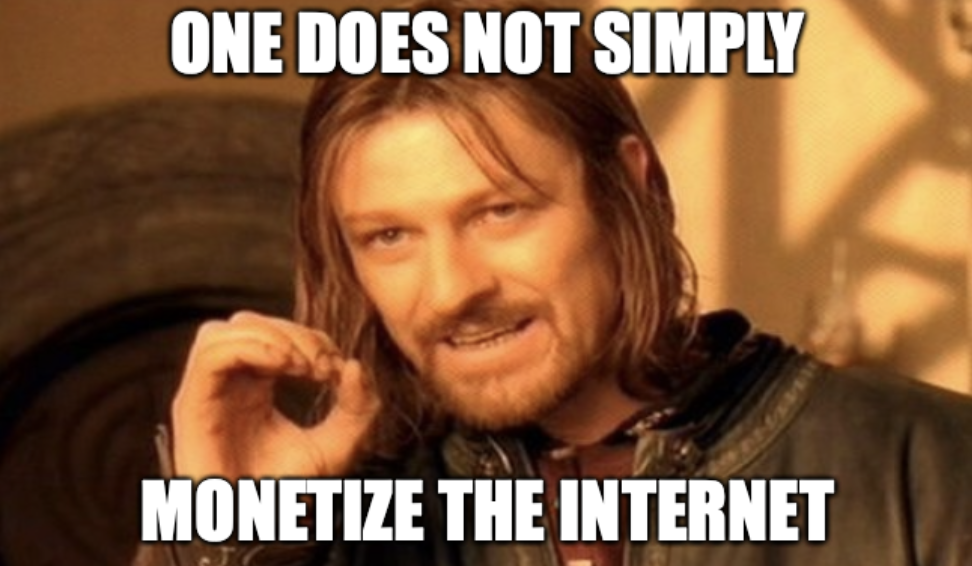Viral images/videos are, at their essence, data. Sometimes this data travels the world many times over to the point it becomes a part of a culture’s shared experience. Today there are few opportunities to monetize a meme or any form of unique data on the Internet without access to large centralized platforms like Instagram or YouTube. The “network effect” benefits the network provider, not the content creator. TikTok is simply a new version of a record label.
According to LifeHacker:
The biggest TikTok influencers—ones like Charli D’Amelio (101.5 million followers), Michael Le (42.4 million followers), and Josh Richards (23.4 million followers)—all made at least $1 million in 2020, according to Forbes. However, most of that money is earned through the sales of merchandise and sponsored content for big brands, rather than ad revenue. In fact, TikTok only recently started to share ad revenue through its Creator’s Fund, which content creators have criticized for being underfunded, as they claim it typically only provides a few dollars per day.
They key here is that the biggest TikTok content creators do not make the majority of their revenue on TikTok yet TikTok is worth Billions. Many other examples include celebrities who, in addition to having a platform on Youtube, Twitch or TikTok, add an OnlyFans page so they can more easily facilitate receiving payments for their content.
This is all the early stage of something much, much bigger. A “new paradigm” where value is transacted peer to peer.
New markets begin with price discovery. During price discovery markets are very inefficient but eventually trend towards efficiency as they mature. To get my point across while being meta:

I assert we are in Medieval times with regards to monetizing data. There is a long road ahead to ending the centralized plutocracy where our personal data is a profit center for faceless and powerful elite. The key to breaking free is the stranglehold financial institutions have on transacting value. To be clear, I’m not much of a data conspiracy theorist nor am I anti-banks, but I do foresee a shift and a new world ahead.
Let’s look at some examples. First up is “disaster girl”. She’s 21 now and is selling an NFT for $500,000. Does that make you feel old? Does it make you feel poor? Does it make you feel old and poor?
The first good NFT. https://t.co/4492QVI1kX
— Harry McCracken 🇺🇦✡️ (@harrymccracken) April 29, 2021
Take a moment to ponder this transaction in context. NFTs are a new and extremely inefficient market fetching outrageous prices. What’s the point of owning a piece of viral internet history? How does it provide a ROI? In the future, each web page featuring a meme, or any piece of data that has value, could be monetized per view, if there were a low cost and efficient way to process a micro transaction.
TikTok could implement advanced revenue sharing per page view if they could get their head around the incentives. They probably won’t, but the next TikTok definitely will.
Another example of market discovery would be the NBA’s NFT collection:
The NBA’s Golden State Warriors have become the first major professional sports team to sell its own non-fungible tokens. These tokens, or NFTs, will be officially licensed digital memorabilia the team is calling its “legacy” collection. An NFT is a verifiable digital asset vouchsafed by blockchain technology.
You could be the owner of a GIF and a provable chain of custody on a blockchain that may or may not exist in 5-10 years for a few thousand dollars. What a deal!
The Warriors are the first U.S. sports team to release their own NFT collection.
It features a 1-of-1 Six-Time NBA Champion Ring NFT combining all of their championships — the highest bidder will get a one-of-a-kind physical ring.
(🎥: @darrenrovell) pic.twitter.com/jyNVhpDc0b
— Front Office Sports (@FOS) April 27, 2021
Again, I point back to the fact that new markets are very inefficient. The craze for NFTs are like the craze for Beanie Babies. I can’t predict the future, and I don’t anticipate the death of NFTs, but I do think NFTs will evolve quickly and the value in owning a limited edition manufactured GIF will be very low in the future and likely near zero.
What will have value in the future will be original content and links to physical assets. Musicians publishing new songs, artwork and funny cat videos. Markets will move towards an efficient solution. I believe that solution will mature as we understand that data is the new money.
A meme is a particular yet valuable type of data. But rather than selling an NFT of a viral moment the world will move to a pay per view model. A fraction of a fraction of a cent per web page view creates an Internet based on value incentives. The Internet will transition to a series of micro transactions that are so small they are barely noticeable but, in aggregate, will add up to sustainable direct revenue to the content creator and will bypass the blood sucking middlemen. Content creators will be on the top of pyramid rather than the bottom.
Markets do not stay inefficient for long and we are on the cusp of the biggest market shift in human history. The market for data.
People will pay hundreds per month for subscriptions to NFLX, DIS and cable but they can't wrap their head around viewing a web page free of ads or data trackers for a fraction of a penny.
— Coinspeak (@coinspeak_io) April 29, 2021
The first platform to explore this market and capitalize on it will see wild success in the future but it will not be a platform deriving their revenue from traditional online sources.
NFTs will find their proper place. They will be used to track unique objects in the physical world. They will be used to transfer ownership of houses, cars and anything of value. In the future “disaster girl” would prove her ownership of her viral picture with licensing fees routing directly to her BitCoin wallet. It’s a big leap but I see markets solving this problem within a few years. Creators can build a content library that generates revenue for a lifetime.
The reason that valuing content in this matter has not already happened is we have had no way to interact peer to peer for small transactions. The third party processing costs were such that it was not efficient, or so we were told. YouTube is valued in the billions but the top 1% of 1% only make $20M. That seems like a pretty efficient revenue generator for YouTube but doesn’t scale per view? The barrier to entry is…..small transactions.
This is changing, if you know where to look.
Bit equals data.
Coin equals money.
Data is the new money.
BitCoin combines data and money.
HODL till your heart’s content but if your coin of choice can’t be used for micro transactions I suspect you’ll be on the wrong side of history.
 Coinspeak Technical and Fundamental Market Analysis
Coinspeak Technical and Fundamental Market Analysis




